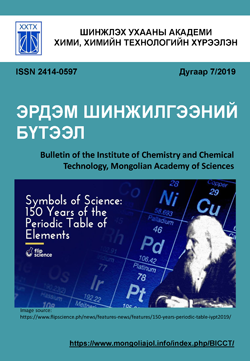Characterization of mica from bodonchiin gol deposit (Mongolia)
DOI:
https://doi.org/10.5564/bicct.v0i7.1269Keywords:
mica, muscovite, clay minerals, biotiteAbstract
Although there are many mica deposits in Mongolia, there is no substantial study of the composition of the mica and the chemical composition and on their utilization. In this work, we characterized the minerals composition of two different samples which was located on the surface (mica-1) and in 10 m depth from the surface (mica-2) of the Bodonchin river deposit from Altai sum, Khovd province (Mongolia). The main objective of this research work was to prepare nanoporous materials from clay minerals by a different acid leaching condition. In order to evaluate the leaching characteristics, the chemical composition, mineral composition, bonding characteristics and specific surface area of mica samples were determined by X-ray fluorescence, X-ray diffractometer, FTIR and BET method, respectively. The main chemical composition of mica sample-1 consists of silicon dioxide 45.68%, and aluminum oxide 31.22%, potassium oxide 10.51% while mica sample-2 contains silicon dioxide 45.2%, and aluminum oxide 38.5%, potassium oxide 10.31%, respectively. These samples also contained the lesser amount of iron and magnesium. The specific surface areas vary from 13.11 to 14.65 m2/g. The main mineral compound of both mica samples was muscovite (KAl2(AlSi3O10)(OH)2. There is negligible influence of the sample’s location on the chemical and mineralogical compositions of the mica.
Бодончийн голын гялтгануурын найрлага, шинж чанарын судалгаа
Хураангуй: Монгол оронд гялтгануурын орд газрууд цөөнгүй байдаг хэдий ч гялтгануурын нөөцийг нарийвчлан тогтоож, химийн найрлага болон эрдэс зүйн судалгааг хийсэн дорвитой судалгааны ажил төдийлөн байхгүй байна. Бид энэхүү судалгааны ажилдаа Ховд аймгийн, Алтай сумын Бодончийн голын гялтгануурын ордын ил газрын гадарга (гялтгануур-1) болон гүнийн (гялтгануур-2) гэсэн хоёр дээжийг сонгон авч шинж чанар, эрдэс бүрдэл зэргийг нарийвчлан судаллаа. Энэхүү судалгааны ажлын гол ач холбогдол нь өөрийн орны шаварлаг эрдсийг ашиглан шинэ материал гарган авах буюу өөрөөр хэлбэл, шаварлаг эрдсийг янз бүрийн нөхцөлд хүчлийн уусгалтанд оруулан нано нүх сүвэрхэг материал гарган авах ажлын үндсэн суурь судалгааны материал болох юм.
Гялтгануурын дээжнүүдийн химийн найрлагыг рентгенфлуоросценц (XRF), эрдсийн найрлагыг рентгендиффрактометр (XRD), функциональ бүлгүүдийг нил улаан туяаны спектроскопийн арга (FTIR) болон нунтгийн хувийн гадаргуугийн талбайг багажит шинжилгээний аргаар (BET) тус тус тодорхойллоо.
Химийн найрлагын хувьд гялтгануур-1 дээжинд цахиурын оксид 45.68%, хөнгөнцагааны оксид 31.22%, гялтгануур-2 дээжинд цахиурын оксид 45.2%, хөнгөнцагааны оксид 38.5% тус тус агуулагдаж байна. Мөн бага хэмжээний төмөр болон магни агуулсан байгааг тогтоолоо. Дээжнүүдийн хувийн гадаргуугийн талбай 13.11 - 14.65 м2/г байна. Гялтгануурын эрдсийн найрлагын судалгаагаар дээрхи 2 дээжинд голлон мусковитын (KAl2(AlSi3O10)(OH)2) төрлийн эрдэс байгааг тогтоолоо.
Түлхүүр үг: гялтгануур, мусковит, шаварлаг эрдэс, биотит .
Downloads
1024
Downloads
Published
How to Cite
Issue
Section
License
Copyright on any research article in the Bulletin of the Institute of Chemistry and Chemical Technology, MAS is retained by the author(s).
The authors grant the Bulletin of the Institute of Chemistry and Chemical Technology, MAS a license to publish the article and identify itself as the original publisher.

Articles in the Bulletin of the Institute of Chemistry and Chemical Technology, MAS are Open Access articles published under a Creative Commons Attribution 4.0 International License CC BY.
This license permits use, distribution and reproduction in any medium, provided the original work is properly cited.

